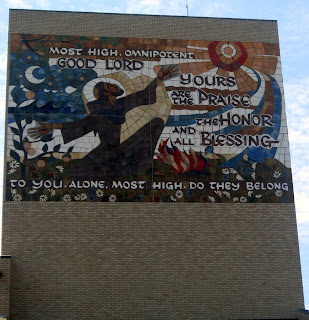 |
| Ismail Gasprinskiy in his office in Bakchiseray. |
Recently, as they do every year, the library celebrated the anniversary of the birth of Ismail Gasprinskiy (March 21, 1851). The day began with a ceremony of tributes at the Gasprinskiy monument located on the Salgir River in the center of Simferopol. A two-hour seminar on Gasprinskiy’s life and work was held at the Franco Library, and on the following day, a celebration was held in the nearby city of Bakchiseray, where Gasprinskiy lived for most of his life and where he is buried.
The festivities made me think once again about this remarkable man and how so little is known of him in the western world. And perhaps because I am currently showing the recent PBS special on the history of the American women’s movement to students at the Window on America Center in Simferopol, I also thought about Gasprinskiy’s views on women and how he truly is someone we would call a “feminist.”
At a time when women were almost universally seen as inferior to men, particularly in the Muslim world, Gasprinskiy had the courage to speak out, demanding to be heard on the importance of changing the attitude towards and treatment of women. In the pages of his newspaper Terdjiman which he published from 1887 until his death in 1914, Gasprinskiy criticized the practice of polygamy and arranged marriages and divorce being a prerogative for men only. Edward Lazzerini, the foremost western scholar on Ismail Gasprinskiy, writes that “Gasprinskii insisted that ‘evolution in the marriage laws’ had become a necessity” and Gasprinskii felt that “what was needed…was a regularization of the laws so that men would no longer be able to repudiate their wives arbitrarily, and women would be permitted to divorce their husband for just cause.”
His own marriage to Bibi-Zuhre hanim Akchurina seemed to have been a partnership in the modern sense: “the union of two determined young people who valued the role education could play in the enlightenment of the Muslims of the Russian empire and who were ready to dedicate their energies to achieve this goal,” writes Azade-Ayse Rorlich, translator and editor of the only book of Gasprinskiy’s writings available in English. Zuhre hanim played a vital role in the publication of Ismail Gasprinskiy’s renowned newspaper, Terdjiman, according to Rorlich: “Even though her name did not appear in the paper… Terjuman would have neither become a reality, nor endured, had it not been for the material and moral support of his wife Zuhre, as well as for her very real contribution to running the paper.”
Perhaps what Gasprinskiy is most known for is his belief in the importance of the education of Muslim women. In his words: “Whoever loves his own people and wishes it a great future, must concern himself with the enlightenment and education for women, restore freedom and independence to them, and give wide scope to the development of their mind and capabilities.”
He was quick to publicize any evidence of attempts to improve education for Muslim women, such as the opening of schools especially for girls. In Bakchiseray, his sister opened the first school for girls of the new method schools (Gasprinskiy’s modernization of Muslim education which was widespread across the Russian empire). With his daughter Sefika, Gasprinskiy started the first magazine devoted to Muslim women. And in his fiction writings, he often created strong women characters that embodied his ideas of modern women, in the belief that his writings would “inspire the real-life Muslim woman to utilize fully her capabilities as a human being, and real-life Muslim society to permit her the opportunity to do so.” (Lazzerini)
It was in such writing that I came to see how well Gasprinskiy understood the role of society in keeping women oppressed. French and American Letters, the only collection of Gasprinskiy’s writings available in an English translation, are excerpts from a fictional travelogue that he serialized in Terdjiman. It follows the adventures of a Muslim man from Central Asia and his travels to France and Africa, and at least some of the writing is loosely based on Gasprinskiy’s own life.
But the last letters are pure fantasy and recount his and his travelling companions’ capture by a band of “Amazons” in Africa. In this Amazon society, gender roles are reversed—men are sexual slaves, women are rulers and warriors. There is much discussion among the men about this reversal of roles and titillating humor when one of the captured men is summoned into the “harem” of the Amazon sultana. In the end, the men escape but not before doing fierce battle with the Amazons. Gasprinskiy writes:
“The amazons flew toward our improvised fortification with extraordinary speed and courage…the Frenchmen…marveled at the spirit and courage of these desert riders. The life and courage of these amazons… clearly proved that education and world views could endow women with much courage, strength, and fortitude…It became clear that in other countries women were fearful, weak, had a delicate nature, frail nerves and no will of their own, not because that is how it should be, but because their education, world view, and those life conditions which had shaped them over time, had made them what they were. “
Truly, Ismail Gasprinskiy was a man far ahead of his time. His radical view that women are equal to men and it is society that is holding them back would resonate today and earn him the label of “feminist.”
The information for this blog post came from these sources:
Gasprali, Ismail. French and African Letters, Annotated Translation and Introduction by Azade-Ayse Rorlich, Istanbul: The Isis Press. 2008
Lazzerini, Edward. “Ismail Bey Gasprinskii and Muslim Modernism in Russia, 1871-1914,” unpublished dissertation, University of Washington, 1973.
Fisher, Alan. "A Model Leader for Asia. Ismail Gaspirali." In The Tatars of Crimea: Return to the Homeland, ed. Edward A. Allworth, Duke University Press, 1998.
Note: There are many different spellings of Gasprinskiy, based on the translation of the original language—T





































